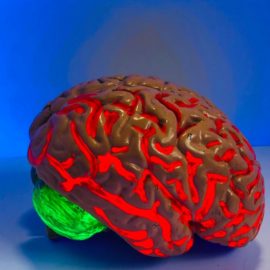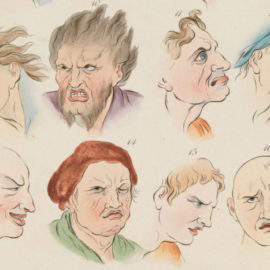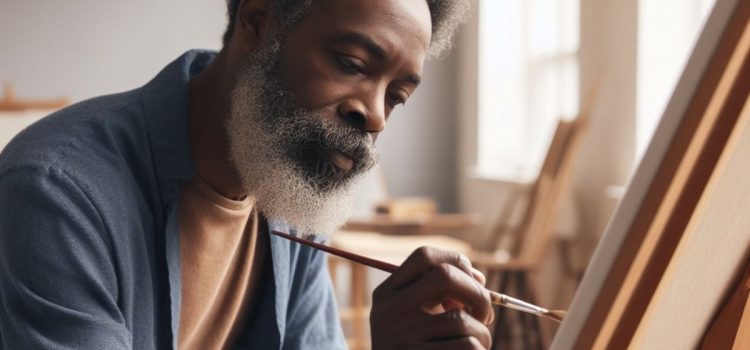
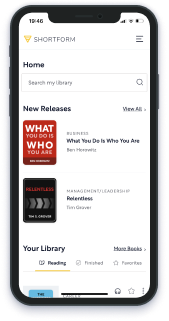
This article gives you a glimpse of what you can learn with Shortform. Shortform has the world’s best guides to 1000+ nonfiction books, plus other resources to help you accelerate your learning.
Want to learn faster and get smarter? Sign up for a free trial here .
Are you suffering from a creative block? Do you want to know how to be more creative?
Creativity doesn’t come naturally to some people. But everyone has an inner artist that can be released—it just takes some practice and the right mindset to get the creative juices flowing.
Check out how to be more creative in six steps.
Step 1: Have Process-Based Goals
In Keep Going, Austin Kleon says that to be more creative without feeling overwhelmed or burned out, you have to use your creativity to pursue the right goals. He separates creative goals into two categories:
- Unhealthy results-based goals
- Healthy process-based goals
Results-based goals are unhealthy because they minimize what’s most important: making creative work that you enjoy or are passionate about. By focusing more on the end product, you focus less on the actual creative process and the things you enjoy about it. In addition, results-based goals pressure you to constantly churn out more work to achieve those results—leading to burnout.
On the other hand, process-based goals make creating work an exciting and joyful experience. This is because process-based goals allow you to enjoy the work itself and avoid feeling pressured to complete it. This prevents you from having to go through the cynical disinterest of burnout or the anxiety and dread of feeling overwhelmed.
To pursue healthier, process-based creative goals, Kleon suggests taking time to make art for yourself and a loved one.
- Making art for yourself. Make some creative work that’s just for you—this will help you enjoy the process of creation without having to worry about what anyone else thinks. You can store this work away somewhere, or even destroy it right after you finish making it. What matters is that you practiced creativity and took joy in that practice.
- Making art for a loved one. Make a piece of creative work as a gift for someone you love or care about. The positive feelings you have toward them will serve as motivation for your work. You’ll also share in the joy they feel when they receive your gift—this gives you concrete, positive reasons to continue making creative work.
Step 2: Make a Creative Space
Keep Going also suggests you can help keep yourself in the moment by using a specific place for your creative work. Ideally, this space should allow you to block out external distractions and stimulate your creativity.
In addition to simply having a separate creative workspace, psychological research suggests there are many benefits of having control over the design of this space. Studies found that those who can design their own workspaces aren’t just more creative—they also tend to be happier, healthier, and more productive.
He says the ideal creative space has two main qualities: solitary silence and creative messiness.
- Solitary silence. Your creative space should allow you to be alone in a quiet place. When you no longer have to focus on external stimulation, you can focus on internal stimulation: your creative thoughts.
- Creative messiness. Kleon explains that there’s a level of messiness that’s just right for creativity: If it’s too messy, you won’t be able to find what you need for your work. On the other hand, if it’s too tidy, you can’t find creative inspiration from the various unrelated things in a messy space. When your space gets too messy and you tidy up, pay attention to everything you come across—looking through old forgotten things can inspire new ideas.
Psychological research supports Kleon’s idea that a balance between messiness and tidiness is ideal—one study found that while tidiness is correlated with healthier, more generous decision-making, messiness is correlated with creativity. This suggests that a “just right” approach to balancing messiness and tidiness allows you to better approach a multitude of situations.
Step 3: Change Your Mindset
Creativity is more than just your goals and a workspace. It’s also about the mindset you’re in throughout the creative process. Before you jump into a creative project, there may be some mindset adjustments to make to ensure your process is as smooth and joyous as possible. Let’s look at the adjustments you need to make to be more creative, according to Big Magic by Elizabeth Gilbert.
- Accept your fear. One of the first things you must do as you begin your creative journey, says Gilbert, is find a way to manage your fear. She believes fear is omnipresent when we are trying to be creative. This is because fear’s main purpose is to protect us in situations of uncertainty, and, unfortunately, the creative process is full of uncertainty. To deal with your fear gracefully, Gilbert recommends making space alongside your creativity for your fear, so that they can comfortably coexist. Treat fear as a friend.
- Focus only on the journey. As you approach a project, Gilbert also stresses that your enjoyment of the creative journey should be your only focus. Let go of any goals or desired outcomes and prioritize the process. According to Gilbert, if you create to receive external validation or to achieve something particular, you make your creativity contingent upon forces outside of your control.
- Don’t be creative to earn money. Gilbert also specifically advises against being creative to earn a living. Practically speaking, she says, creative work can rarely pay bills. Relying on your creative pursuits to keep you afloat may leave you in dire financial straits, which may force you to give up your creative work altogether.
- Cooperate with a new idea. Finally, when your first idea visits you, work with it, insists Gilbert. Don’t fret over the idea, fight with it, or put it off (which are all common responses). Think of your idea as a human creative partner, and treat it with dignity and respect.
Step 4: Connect With Your Inner Artist
In The Artist’s Way, Julia Cameron argues that human beings are creative by nature and that there’s a divine creative force that flows through all of us. This creative force is Cameron’s concept of “God.” She elaborates that you’re not required to call this force “God,” or to associate it or yourself with any religion; however, to maximize your creative potential and attain your artistic destiny, you must believe in and learn how to tap into this force so it can flow through you and into your art. (Cameron refers to “art” as anything you use creativity to produce—art could be poetry, painting, philosophy, coding, developing new chemical compounds, and so on.)
To tap into the creative force, Cameron explains, you need to gain an intimate connection to your inner artist—your deeper creative self that contains your seemingly crazy ideas, raw emotions, dreams, desires, and so on. This inner artist is a conduit for the creative force. The more intimate you are with this self, the more creative and artistically guided you’ll be.
Here’s Cameron’s advice on how to be more creative by uncovering and connecting to your inner artist:
- Write morning pages. These are three full pages written every morning right after waking up. These pages can be about anything—last night’s dreams, your plans for the day, or things you’re excited or worried about. Don’t worry about making these coherent or well-written—just consider them a “brain dump.” Morning pages help you connect with your inner artist in numerous ways. First, they clear your head of negative thoughts, concerns, and extraneous information that impact your mood or focus during the day. Further, Cameron argues that brain-dumping through morning pages often uncovers hidden yet meaningful feelings and ideas that may otherwise remain unsurfaced.
- Go on solo adventures. Cameron recommends taking yourself on at least one fun solo adventure (or “artist date”) a week. These solo excursions are the perfect opportunity for you to gain inspiration and reflect on some of the deeper thoughts, feelings, and ideas you may have uncovered in your morning pages. Further, Cameron explains that solitude is crucial to connect with your inner artist—this is the time when your creative self recharges.
- Uncover the lost parts of your inner artist. To reacquaint yourself with the lost parts of your inner artist, Cameron recommends first reflecting on your childhood dreams and desires. Then, reflect on any of your recent or current dreams, desires, or ideas that you’ve convinced yourself not to explore—for money, time, practicality, and so on.
- Understand your inner artist’s emotions and intuition. Cameron explains that as you grow closer to your inner artist, you’ll experience a stronger sense of emotion and intuition. This can be overwhelming; therefore, you must understand and interpret these experiences to channel them into creativity and art. When this happens, Cameron says you must take advantage of your emotions and trust your intuition. Many people convince themselves that synchronicities are coincidences, or that they’re unworthy of taking advantage of these synchronicities (they’ll fail or let themselves down in some way). Fight this urge, trust your intuition, follow the path that’s being opened for you, and Cameron says that you’ll end up exactly where you need to be.
- Engage with your inner artist in small ways. Cameron recommends finding small ways to spark your creativity and engage with your inner artist that you can integrate into your daily life. One of the best ways to do so, she explains, is through movement—for example, doing yoga or going for a stroll. This helps you become more in tune with your feelings and makes you more likely to notice beauty and synchronicities around you.
Step 5: Surround Yourself With Inspiration
Once you’ve set up your life in a way that allows you to focus on creating, it’s time to start pulling inspiration from the work of other artists. According to Steal Like an Artist by Austin Kleon, there is no such thing as a wholly original piece of creative work—every creator is influenced by other creators in some way. Accepting this truth releases you from the pressure of creating something the world has never seen before.
In Kleon’s view, once you embrace the creative influence other artists have on you, your job is to curate that influence. Do this by filling your physical and digital spaces with art, ideas, objects, and people that move and inspire you; this will set the tone for your own creative work. On the flip side, if you surround yourself with things that bore or depress you, that will negatively impact your own work.
Where should you start searching for inspiration to surround yourself with? If you’re overwhelmed with prospects, Kleon recommends starting by totally immersing yourself in one person’s work that deeply moves you. Study everything you can about them as both a person and an artist as you surround yourself with their work. Then, do the same with the people who influenced them. This way, you’ll feel connected to other creators, whether past or present.
Step 6: Share Your Work
Seth Godin, author of The Practice, believes it’s important to share your creative work regularly and on a schedule. Promising to deliver your work can help you be more creative, and sharing your work allows you to receive feedback from your audience. Engaging with your audience is important because it will either give them something they want, or it will teach you what’s not working with what you created.
When you share your work, some of it might work for some people, but not others; some of it might not work at all. The goal is not to get reassurance from your audience; it’s to incorporate useful feedback to improve your work.
Godin points out that a lot of criticism isn’t worth paying attention to. This includes criticism from internet trolls or people who aren’t your intended audience. For example, people who like meandering, lyrical ballads aren’t going to like your rap music, so it doesn’t matter what they have to say. The only criticism worth paying attention to is criticism from people who tell you what’s not working for them without indicting you personally.
Final Words
It doesn’t matter if you’re an inspiring artist or a mathematician, you need to be a little creative to turn your ideas into reality. It just might take a little work to awaken your creative spirit. If you follow the above steps on how to be more creative, you may open up a new world of potential.
Do you have advice on how to be more creative? Let us know in the comments below!
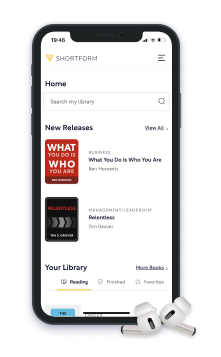
Want to fast-track your learning? With Shortform, you’ll gain insights you won't find anywhere else .
Here's what you’ll get when you sign up for Shortform :
- Complicated ideas explained in simple and concise ways
- Smart analysis that connects what you’re reading to other key concepts
- Writing with zero fluff because we know how important your time is


